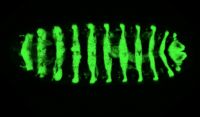 NOTÍCIES
NOTÍCIES
Physics also matters for positional control during development
- New study shows how contractile forces lead collective cell movement and control segment position during fly development. The right positioning of these segments is crucial for proper development.
- It is the first time that scientists identify that genes essential for patterning of an organism are also involved in the control of the position of segments by acting on cell mechanics.
Cells move and migrate to shape an organism during the early stages of development. This choreographed movement in which the mass of cells will be oriented giving rise to an organism has been deeply studied from a genetic point of view. Now, a team of scientists at the Centre for Genomic Regulation led by Jérôme Solon, describe the physical mechanisms driving collective cell movements in a so far unexplored process during development.
Scientists focused on a particular process of the fruit fly development: the head involution. During this process, the epidermis spreads anteriorly to envelope the head tissues and fully cover the embryo. This results in an even positioning of epidermal segments along the embryo that will give rise to the different organs of the fly.
“The tissue rearrangement occurring in this developmental process is similar than in wound healing. It requires collective movement of cells and we described that epidermal movement is in part driven by a contractile actomyosin cable at the front of the moving tissue. So a contractile ring forms,and generates tissue movements in the same way as when we propel a soap from our hand just by squeezing it with our fingers. The interesting observation, here, is that these contractile rings are present regularly all along the embryo like many squeezing hands, generating the circumferential tension which leads into spreading and positioning of cells along the organism,” explain Natalia Czerniak and Kai Dierkes, co-first authors of this paper and researchers at the Solon laboratoy in the CRG.
Their results suggest not only that circumferential forces drive epithelial spreading but also that these forces are crucial for positioning of epidermal segments. “We looked at the mechanical and physical aspects of this process and described the mechanisms driving epidermal spreading and segment positioning for the first time,” states Jérôme Solon, CRG group leader and main author of the paper. He adds, “We have also observed a relationship between this process (head involution) and dorsal closure, another morphogenic movement occurring at the same time. Both processes help each other. So, our work strengthens the Drosophila embryogenesis as a promising model system for future studies on the crosstalk between two distinct processes”.
A physical approach of these processes helps us to better understand embryogenesis, tissue rearrangement, and cell migration, which may lead to better address some developmental defects such as spina bifida or wound healing in the future.
Reference: Natalia Dorota Czerniak, Kai Dierkes, Arturo D’Angelo, Julien Colombelli, and Jérôme Solon. “Patterned contractile forces promote epidermal spreading and regulate segment positioning during Drosophila head involution” Current Biology. 2016. DOI: http://dx.doi.org/10.1016/j.cub.2016.05.027
For further information and interviews, please contact:
Centre for Genomic Regulation (CRG) – Press Office - Laia Cendrós
email: laia.cendros@crg.eu - Ph. +34 93 316 0237 – Mobile +34 607 611 798

